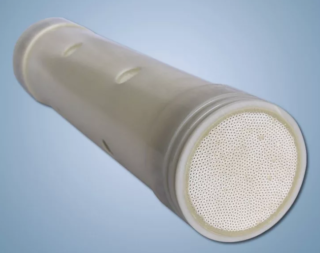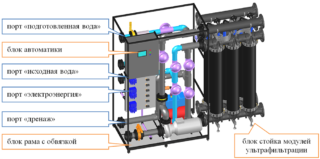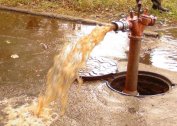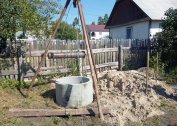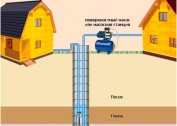Ultrafiltration and ultraviolet are two different things. Irradiation, that is, water purification by ultraviolet radiation, is the impact of a certain spectrum of light on bacteria and parasites, in which they are destroyed. This should be done at the final stage of liquid purification. Ultrafiltration or ultrafiltration is the use of a filter with very small pores through which even viruses cannot pass. You should consider this method in more detail.
Ultrafiltration - definition and scope
All membrane water pre-treatment requirements are met only by membrane technologies - nanofiltration, reverse osmosis systems, UV filter for water. Compared to the old methods - electrocoagulation, installation of ultraviolet disinfection of drinking water, chlorination - they are the most progressive and every year give an increase in the quantity of high-quality clean drinking water.
Ultrafiltration is the removal of suspended particles using ultrafine pore filters. For example, the size of the virus is 0.02 microns, and the pores - 0.01 microns.
Before final cleaning, the liquid should not contain substances that affect the turbidity indicator - organic and inorganic pollutants. Therefore, at the initial stage of the process, ultrafiltration units are used that purify water from 99.99% of substances. This allows you to save subsequent filters and increase the service life.
Pore size varies depending on the initial quality of the liquid. If the intake comes from surface sources, a better filter is required. When supplying water from underground wells, filters with increased porosity can be dispensed with.
Industrial UV filters are used in the production of wine, cognac products, as well as liquid food products - milk, juices. They are installed at refineries for the treatment of wastewater from oil products, oils. In large quantities - by cassette or cascade method - filters are used in drinking water factories.
Operating principle
The main objective of the ultrafilter is disinfection and clarification of the liquid. This happens when water passes through the membrane. There are two ways - pressure and non-pressure. In the first case, the liquid passes through the membrane layer under pressure created by the pump, in the second case, a rarefied space is created from the inside, and water is absorbed by the membrane.
Filter modules are usually located vertically so that the liquid is evenly distributed. Elements of the system are arranged in the following sequence:
- Water intake or supply pipe.
- Pressure regulating pump.
- The filter with a membrane.
- A tank or pipe for clean water.
- Pipe for discharge of waste and liquid after flushing the system.
The membrane is often clogged, so when debugging equipment, the specialist sets the optimal pressure and frequency of flushing the system. Rinsing occurs in two ways - by a counter flow from an already purified liquid or by drainage from a water intake pipe. Waste is dumped in a separate container and disposed of.
Membrane Materials
The main material used to make the finely porous membrane is polysulfone. This substance is resistant to acids, alkalis, alcohols.The new generation polysulfone withstands temperatures up to 200 degrees, gives small shrinkage and expansion with changes in temperature conditions, so it is used for the manufacture of parts that must keep their shape in any conditions. The fibers are hollow in structure, so the material is used for the manufacture of reverse osmosis filters and in ultrafiltration systems. The weak point of polyester sulfone is chlorine compounds; therefore, the main criterion for the service life is the work with chlorinated liquid, calculated in hours.
Ceramic membrane is considered more durable. It can serve for decades, since bacteria cannot damage it. Clean it with ordinary detergents - vinegar, soda, or even mustard powder. Ceramics are cheaper to maintain, since there is no expense for disinfecting substances that process the other membranes so that colonies of microorganisms do not form on them.
The ultrafiltration system of water
The general scheme of the system, which includes an ultrafilter, contains a rough mechanical filter that traps sand, silt, bottom sediments, and large organics. Further, the liquid under pressure through the inlet pipe enters directly into the UV filter, the main cleaning process begins. Water seeps through the porous membrane and enters the outlet pipe. There are systems in which a reverse flow of permeate (filtrate or pure water) is possible in order to wash away the layers of accumulated organic matter from the membrane. This process is configured and works automatically. Depending on the degree of contamination of the initial liquid, washing is done more often or less.
Next, the filtrate enters the reverse osmosis system and undergoes further purification. UV lamps for water treatment are usually not required, since at this stage all dangerous bacteria and viruses are removed from the liquid.
Advantages and disadvantages of the method
The ultrafiltration method allows you to:
- maintain the quality of drinking water at a high level, avoiding fluctuations in the direction of deterioration;
- reduce the cost of water for the population thanks to a simple cleaning mechanism;
- reduce the level of hazardous compounds that are formed when using chlorine;
- install small-sized installations in an apartment or apply large systems for high-rise buildings or individual areas of the city;
- choose the installation according to the pressure in the pipeline;
- save energy.
After filtration, the water contains all useful salts, so mineralization is not required. There are no heavy metals in the purified liquid.
Of the disadvantages, the most significant is the inability of the filter to retain dissolved inorganic compounds - sodium, calcium. Liquids at enterprises may contain other hazardous substances, whose molecules do not exceed the pore diameter of the membrane in size. It is impossible to soften water using this method, therefore, other filters are used.
The use of a UV filter is preferable for non-chlorinated water, since chlorine damages the fibers and renders the material unusable. Other methods of purification are used to neutralize chlorine, for example, the ion-exchange method.
Criterias of choice
On sale you can find household compact models and larger ones, designed for enterprises, high-rise buildings.
To choose the right ultrafilter, you need to consider:
- the family’s need for clean water - how many liters a day is spent - the cost will depend on this indicator;
- what material is used in the manufacture of the membrane - the service life and the ability to self-repair the cleaning mechanism depend on this;
- how much the product withstands hot water;
- pressure in the city water supply;
- pore size, which will determine how well the water will be cleaned.
Since filters of this type are not cheap, it is important to consider all indicators so as not to overpay too much. Perhaps the quality of water in the urban system allows you to use it for bathing and washing, as well as washing dishes, but for use inside you need to put an additional filter. In this case, the smallest option is suitable, which is installed in an apartment or office.
Installation and Connection
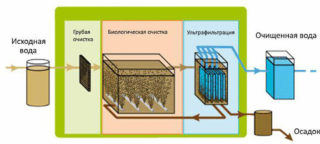 To install the ultrafiltration system, it is not necessary to contact specialists. The installation diagram is attached to each filter, it can be performed using a conventional installation kit. The product is installed on a cold water main.
To install the ultrafiltration system, it is not necessary to contact specialists. The installation diagram is attached to each filter, it can be performed using a conventional installation kit. The product is installed on a cold water main.
If the filter is installed only for the production of drinking water, you must buy an additional tap, which will be installed next to the main one. Sometimes the owners want to have a reserve, so a hydraulic tank is mounted between the tap and the filter, into which the filtrate enters.
Filter installation price
The cost of ultrafilters of various capacities can be considered on the example of products that are manufactured on the basis of the D.P. Mendeleev Russian Chemical-Technological University. The apartment option costs about 19 thousand rubles and is adapted to urban water supply systems. More productive installations for apartment buildings, private cottages cost from 23 to 47 thousand rubles. Industrial filters are the most productive, their cost is about 80 thousand rubles.
For large enterprises specializing in cleaning liquids, they purchase several filters that are connected to cartridges. For insurance, spare blocks should be used in case the working filters are under repair or scheduled maintenance.
